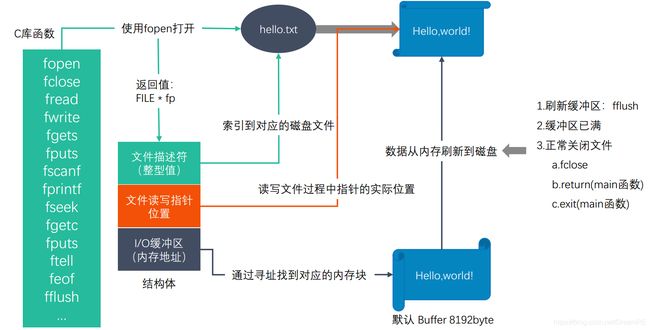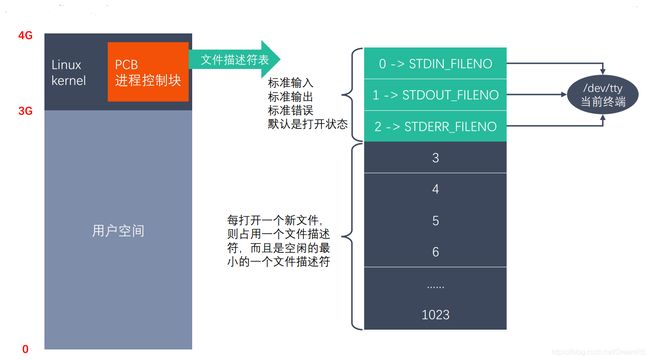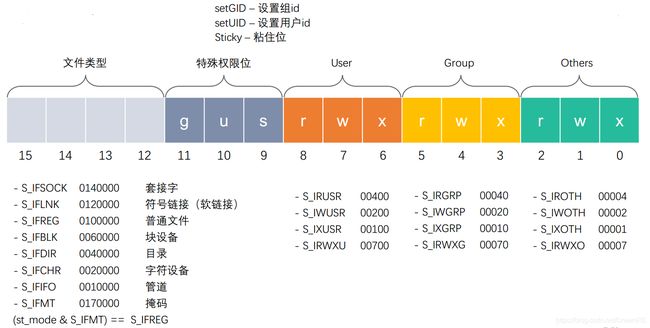Linux系统编程(六)文件IO
Linux系统编程(六)文件IO
-
- 6.1 文件 IO
- 6.2 虚拟地址空间
- 6.3 文件描述符
- 6.4 open 打开文件
- 6.5 open 创建一个新文件
- 6.7 read-读取文件 write-写入函数
- 6.8 lseek 文件位置偏移
- 6.8 stat lstat 获取文件相关信息
- 6.9 实现 ls -l
6.1 文件 IO
在内存角度,I (Input)指将文件从磁盘中读入内存,O (Output) 指将文件从内存中写入磁盘。在 C 语言中,对于文件的操作有如下 API 。

C 语言中的文件处理函数库看做第三方库,在不同平台,会调用底层的文件处理函数,所以是跨平台的,并且其通过缓冲区实现,更加高效易用。下面介绍的 Linux 文件处理函数,是在 Linux 平台下的函数。
对 FILE* 简单说明:
- 文件描述符 :文件 ID,用于指向文件的唯一标识符
- 文件读写指针位置 :维护读写指针,用于读取数据和写数据
- I/O缓冲区(内存地址):内存与磁盘之间IO操作时,通过缓冲区来进行交换,当缓冲区满时,进行写操作,减少IO次数,使得读写效率高。缓冲区默认大小为 8 K。
在网络通信中,实时性有着较高的要求,所以需要Linux 系统的IO函数,对磁盘的文件进行IO时,使用标准C 库中的 IO效率更高。标注 C 库与 Linux 系统的IO函数的关系(调用与被调用)如下:

6.2 虚拟地址空间
进程是系统运行程序运行分配资源最小单位。程序是在磁盘中的代码,而进程是运行的程序,加载至内存中的程序。每个进程加载至内存中,其可以表示为虚拟地址空间,其大小由CPU决定,32位系统,地址空间大小为 2 32 2^{32} 232 (4G),64为系统一般为 2 48 2^{48} 248 。

以32位系统为例,虚拟地址空间 分为用户区和内核区,用户区为0~3G,内核区为3-4G。通过内存管理单元(MMU)映射 至 物理内存。
扩展:虚拟内存管理技术,MMU如何映射内存。
6.3 文件描述符
进程对文件进行操作时,通过内核区的进程控制块(PCB,结构体)中保存的文件描述符表对文件进行管理。

文件描述符表默认大小为1024,即每个进程默认打开的文件个数为1024个。其中,前三个为固定的文件,标准输入(stdin),标准输出(stdout),标准错误(stderror),三个文件指向当前终端,所以进程输入输出默认为终端。
当一个文件被多次打开时,其文件描述符不同。
6.4 open 打开文件
在终端通过命令查看open 文档,open 为 Linux系统函数(第二章),
man 2 open
- 使用
open所需要的包含头文件
#include - 函数接口
// 打开一个已经存在的文件
int open(const char *pathname, int flags);
- 参数
pathname:需要打开的文件路径flags:对文件操作权限的设置及其他设置。O_RDONLY, O_WRONLY, O_RDWR,三个操作互斥,仅能选取一个。
- 返回值
- 调用成功,返回文件描述符
- 调用失败,返回
-1,并设置errorno。
errorno是系统函数库中一个全局变量,记录错误号,且是最近的错误号。使用方式:
void perror(const char *s);用于打印
errorno对应的错误信息。参数s为用户指定的错误描述,输出是格式为 [用户指定的错误描述] : 实际错误信息。
perror打印错误信息, 简单示例
#include 6.5 open 创建一个新文件
- 包含头文件
#include - 函数接口
// 创建一个新的文件
int open(const char *pathname, int flags, mode_t mode);
- 参数
pathname:需要创建文件的路径flags:对文件操作权限的设置及其他设置- 必选项:
O_RDONLY,O_WRONLY,O_RDWR,三个操作互斥,仅能选取一个。 - 可选项:
O_CLOEXEC,O_CREAT,O_DIRECTORY,O_EXCL,O_NOCTTY,O_NOFOLLOW,O_TMPFILE,O_TRUNC
- 必选项:
mode:八进制数,表示用户对创建的新文件的操作权限,计算方式:mode = mode & ~umask
umask 作用为抹去某些权限,使得文件权限更加合理。如 0002 使得其他用户对文件写权限抹去。
- 返回值
- 调用成功,返回文件描述符
- 调用失败,返回
-1,并设置errorno。
#include 6.7 read-读取文件 write-写入函数
- 包含头文件
#include - 函数原型
ssize_t read(int fd, void *buf, size_t count);
- 参数
fd:文件描述符,open得到,通过文件描述符操作文件buffer:传出参数,需要读取的数据存放的 buffer 地址count:指定的数组大小
- 返回值
- 读取成功
- 大于
0表示 返回读取的字节数 - 等于
0表示已经读取至文件结尾
- 大于
- 读取失败,返回
-1,设置error。
write 函数:
- 包含头文件
#include - 函数原型
ssize_t write(int fd, const void *buf, size_t count);
- 参数
fd:文件描述符,open得到,通过文件描述符操作文件buffer:要往磁盘写入的数据,数组count:要写的数据的实际大小
- 返回值
- 写入成功,返回实际写入的字节数
- 写入失败,返回-1,并设置
errorno
拷贝文件示例:
#include 6.8 lseek 文件位置偏移
标准C库中 fseek 对应系统库函数 lseek
- 包含头文件
#include - 函数原型
off_t lseek(int fd, off_t offset, int whence);
- 参数
fd:文件描述符,通过open得到,使用fd操作文件offset:偏移量whence:对文件指偏移offset- SEEK_SET:设置文件偏移量:
offset - SEEK_CUR:设置偏移量:从当前位置 +
offset - SEEK_END:设置偏移量:文件大小 +
offset
作用:
(1)移动文件指针至文件开头:lseek(fd, 0, SEEK_SET);
(2)获取当前文件指针位置:lseek(fd, 0, SEEK_CUR);
(3)获取文件长度:lseek(fd, 0, SEEK_END);
(4)扩展文件长度:lseek(fd, 100, SEEK_END);
- SEEK_SET:设置文件偏移量:
扩展文件示例
#include 6.8 stat lstat 获取文件相关信息
- 包含头文件
#include - 函数原型
int stat(const char *pathname, struct stat *buf);
int fstat(int fd, struct stat *buf);
int lstat(const char *pathname, struct stat *buf);
- 参数
pathname:文件路径statbuf:传出参数,结构体变量,用于保存获取的信息
statbuf 结构体如下
struct stat {
dev_t st_dev; // 文件的设备编号
ino_t st_ino; // 节点
mode_t st_mode; // 文件的类型和存取的权限
nlink_t st_nlink; // 连到该文件的硬连接数目
uid_t st_uid; // 用户ID
gid_t st_gid; // 组ID
dev_t st_rdev; // 设备文件的设备编号
off_t st_size; // 文件字节数(文件大小)
blksize_t st_blksize; // 块大小
blkcnt_t st_blocks; // 块数
time_t st_atime; // 最后一次访问时间
time_t st_mtime; // 最后一次修改时间
time_t st_ctime; // 最后一次改变时间(指属性)
};
- 返回值
- 成功调用时,返回0
- 失败返回 -1 ,设置 errorno
6.9 实现 ls -l
#include 点关注,不迷路。一键三连是对我最大的支持,欢迎关注编程小镇,每天涨一点新姿势。






